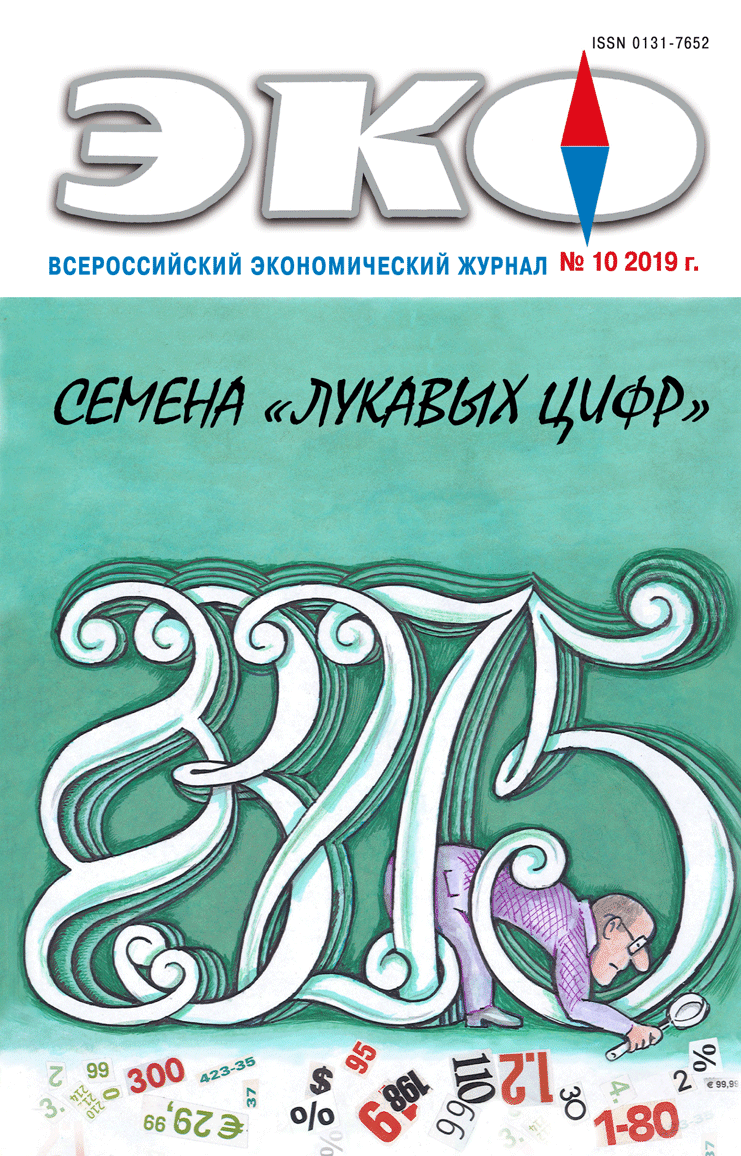Published 2019-10-03
Keywords
- national wealth,
- fixed assets,
- Soviet history,
- USSR statistics,
- reliability of statistical indicators
- political repression,
- postmodernism theories ...More
How to Cite
1.
Fomin Д. National Wealth Statistics and Economic Science. ECO [Internet]. 2019 Oct. 3 [cited 2026 Jan. 19];49(10):172-91. Available from: https://ecotrends.ru/index.php/eco/article/view/3901
Abstract
Up to the end of the 90-s, the Russian statistics used the Soviet methodology to evaluate fixed assets. In order to bring the accounting value of fixed assets to the scale of their replacement value, six general revaluations had been carried out. In 1998, the Russia’s statistical office implemented international statistical standards which meant that the method of continuous stocktaking should be used to account for the value of fixed capital, and general revaluations should be rejected. However, the use of internationally accepted statistical methodology and accounting standards did not raise the reliability of indicators characterizing the value of national wealth elements and did not expand their list. The main reason for increasing degradation of the Russian statistics is a low level of Russia’s economy and inability of its representatives to verify the objectivity of indicators declared by statistics. This situation of Russia’s economics is largely the result of a negative Soviet legacy and repression against leading Soviet economists involved in national wealth valuation. In the post-Soviet period, the negative academic traditions of the economics of the past were not broken, on the contrary, they were strengthened due to mass distribution of postmodern theories among economists which denied that the centuries-old traditional economics would be able to understand the present and destroyed academic intellectual continuity. Postmodernism, unlike traditional economics, does not give a high priority in the economy to national wealth and its basic element, physical capital, and does not consider investment the most important factor of economic growth.References
- Аганбегян А. Г. Плеяда богатырей // ЭКО. 2007. № 8. С. 177–187.
- Голдсмит Р. Национальное богатство США в послевоенный период. М.: Статистика, 1968. 430 с.
- Кваша Я. Б. Послесловие к кн.: Кример Д., Добровольский С., Боренштейн И. Капитал в добывающей и обрабатывающей промышленности США. М.: Изд-во иностр. лит., 1962. С. 531–536.
- Мельянцев В. А. Восток и Запад во втором тысячелетии: экономика, история и современность. М.: Изд-во МГУ, 1996. 304 с.
- Мэддисон Э. Контуры мировой экономики в 1–2030 гг. Очерки по макроэкономической истории. М.: Институт Гайдара, 2015. 584 с.
- Ноув А. Воспоминания об А. Л. Вайнштейне // Экономическая школа. 1993. Т. 3, вып. 3. С. 16–17.
- Паланик Ч. Ссудный день. М.: Изд.-во АСТ, 2018. 384 с.
- Пикетти Т. Капитал в XXI веке. М.: Ад Маргинем Пресс, 2015. 592 с.
- Слуцкий А. Читая Вайнштейна // Экономическая школа. 1993. Т. 3, вып. 3. С. 11–16.
- Фейнман Р. П. Вы, конечно, шутите, мистер Фейман! Похождения удивительного человека, поведанные им Ральфу Лейтону. М.: АСТ: Астрель, 2011. 477 с.
- Фомин Д. А., Ханин Г. И. Динамика основного капитала экономики РФ в постсоветский период (1992–2015 гг.) // Проблемы прогнозирования. 2017. № 4. С. 21–33.
- Ханин Г. И., Фомин Д. А. Инвестиционные, финансовые и институциональные условия возрождения российской промышленности // Journal of Institutional Studies. 2019. № 1 (11). С. 155–175.
- Шумпетер Й. А. История экономического анализа: В 3-х т. Т. 1. СПб.: Экономическая школа, 2004. 496 с.
- Clark C. The Conditions of Economic Progress. London: Macmillan, 1940.

